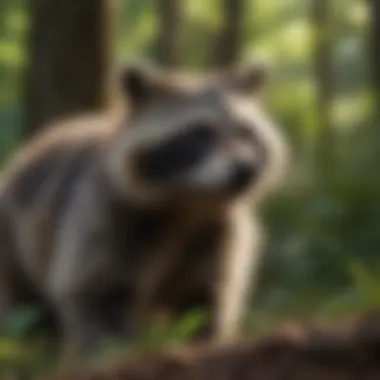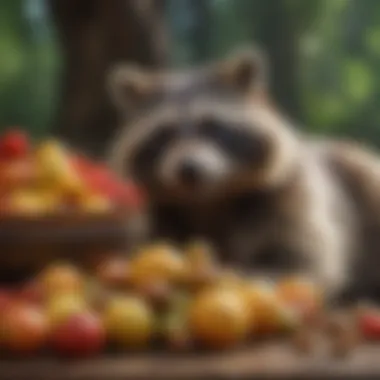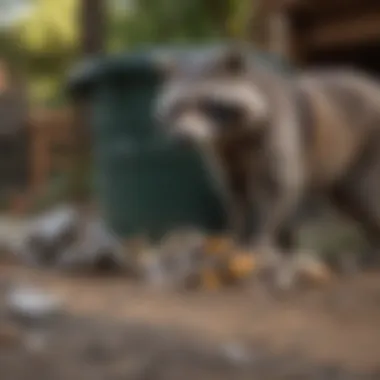Unveiling the Intriguing Dining Patterns of Raccoons in the Wild


Overview of the Topic
Raccoons have garnered fascination for their diverse dietary preferences and unique dining habits in the wild. Their versatile and opportunistic feeding behavior sheds light on their ecological role within their habitats. Understanding what raccoons eat is pivotal in unraveling the intricacies of their diet and how it influences their surroundings.
Current Status and Challenges
An examination of the current state of raccoons' dining habits reveals a blend of adaptability and challenges. The urban expansion encroaches on their natural food sources, leading to conflicts between raccoons and human populations. Additionally, changes in environment and climate present new obstacles for raccoons to navigate in their search for sustenance.
Sustainable Solutions
Exploring sustainable solutions to support raccoons in the face of challenges involves a multi-faceted approach. Implementing wildlife-friendly practices in urban planning and waste management can mitigate human-raccoon conflicts. Education on coexistence and promoting natural habitats can aid in ensuring raccoons have access to a diverse range of food sources.
Impact and Importance
The impact of raccoons' dining habits extends beyond their immediate environment. By examining their foraging behavior and dietary choices, we can gauge the ecosystem's resilience and health. Conservation efforts play a vital role in safeguarding raccoons' ecological contributions and preserving their place in the intricate web of species interactions.
Understanding Raccoons' Diet
In this article, delving into the dietary preferences and eating habits of raccoons is crucial for gaining insight into their versatile and opportunistic feeding behavior. Understanding what raccoons eat provides a deeper comprehension of their diet and ecological role. The dietary patterns of raccoons reflect their adaptive nature and their ability to thrive in a variety of environments.
General Overview
Omnivorous Nature
Raccoons exhibit an omnivorous nature, consuming both plant and animal materials. This trait contributes significantly to their survival as it allows them to obtain a wide range of nutrients from diverse food sources. The omnivorous behavior of raccoons is beneficial for their adaptability in various habitats, ensuring they can sustain themselves on whatever resources are available.
Adaptability to Various Environments
Raccoons' adaptability to different environments is a key factor in their success as opportunistic feeders. This flexibility enables them to adjust their diet based on the food items accessible in each habitat. Their ability to thrive in diverse ecosystems showcases the advantages of their adaptability in foraging and obtaining sustenance.
Key Factors Influencing Diet


Seasonal Variation
Seasonal changes significantly impact raccoons' dietary choices. During different times of the year, the availability of certain food sources fluctuates, influencing what raccoons consume. Their capability to adapt their diet based on seasonal variation enhances their survival in changing environmental conditions.
Habitat Availability
The availability of habitats plays a crucial role in determining raccoons' dietary options. Raccoons are opportunistic feeders, taking advantage of the resources present in their surroundings. The adaptability of raccoons to utilize varied habitats reflects their resourcefulness in finding food sources.
Nutritional Needs
Protein Requirements
Proteins are essential for raccoons' growth and maintenance. Meeting their protein requirements ensures proper development and overall health. Raccoons source proteins from diverse food items, showcasing their dietary flexibility. Balancing protein intake is crucial for sustaining their physiological functions.
Energy Sources
Energy sources fuel raccoons' daily activities and metabolic processes. They derive energy from carbohydrates, fats, and proteins present in their diet. Maintaining a balance in energy sources is vital for supporting raccoons' energy demands and ensuring their vitality in varied environments.
Primary Food Sources
In the realm of raccoon dietary habits, a crucial aspect to explore is their primary food sources. Understanding what raccoons predominantly consume sheds light on their nutritional requirements and foraging behaviors. Raccoons are opportunistic feeders, known for their diverse diet that includes natural, aquatic, and human-related food sources. By examining these primary food sources, we can gain valuable insights into the adaptability and resilience of raccoons in various environments. Their diet plays a significant role in shaping their ecological impact and interactions within ecosystems.
Natural Diet Components
Fruits and Berries
Fruits and berries form a vital component of raccoons' natural diet. These high-energy foods provide essential nutrients and hydration. Raccoons are attracted to a variety of fruits and berries, utilizing their keen sense of smell to locate these food items. The consumption of fruits and berries contributes to the raccoons' overall health and energy levels, sustaining them throughout various seasons. While these food items are beneficial for their nutritional content, overdependence on fruits and berries can lead to challenges in meeting other dietary requirements.
Insects and Invertebrates
Insects and invertebrates play a significant role in diversifying raccoons' diet. Rich in proteins and fats, these small creatures offer a valuable source of nutrients for raccoons. Raccoons display adept hunting skills when foraging for insects and invertebrates, showcasing their opportunistic feeding behavior. The consumption of insects and invertebrates supplements the raccoons' diet, addressing their protein requirements and contributing to their overall dietary balance. However, reliance solely on insects and invertebrates may pose challenges in meeting other nutritional needs.
Small Mammals and Birds


Small mammals and birds represent another important dietary component for raccoons. These prey items provide substantial protein and energy for raccoons, supporting their physiological functions and growth. Raccoons exhibit hunting strategies tailored to capturing small mammals and birds, displaying their carnivorous capabilities despite being omnivorous. Ingesting small mammals and birds helps raccoons meet their high protein requirements and sustains their predatory behaviors. Nevertheless, the predation on small mammals and birds can impact local biodiversity and ecosystem dynamics.
Aquatic Preferences
Fish and Crayfish
The aquatic environment offers raccoons access to fish and crayfish, enriching their diet with valuable protein and essential fats. Raccoons demonstrate adept swimming abilities that enable them to catch fish and crayfish in freshwater bodies. The consumption of fish and crayfish complements their terrestrial diet, providing a diverse range of nutrients crucial for their overall health. While fish and crayfish offer a nutrient-rich food source, the overexploitation of aquatic resources by raccoons can disrupt local aquatic ecosystems.
Aquatic Plants
Aquatic plants serve as an additional dietary option for raccoons, particularly in wetland habitats. These plants contain essential nutrients and fiber that contribute to the raccoons' digestive health. Raccoons exhibit herbivorous tendencies when consuming aquatic plants, showcasing their adaptability to different food sources. The inclusion of aquatic plants in their diet helps raccoons maintain a balanced nutrient intake and supports their digestive processes. However, excessive consumption of aquatic plants can lead to competition with other herbivorous species in the ecosystem.
Human-Related Food Sources
Garbage Bins and Dumpsters
Human-related food sources, such as garbage bins and dumpsters, provide raccoons with easy access to discarded food items. Raccoons demonstrate remarkable scavenging abilities, efficiently navigating urban environments to find food in human-made waste. The consumption of food from garbage bins and dumpsters supplements their diet, offering calorie-rich options not typically found in their natural habitat. While these food sources help raccoons thrive in urban settings, they also raise concerns about human-wildlife conflicts and the spread of diseases through contaminated waste.
Pet Food Leftovers
Pet food leftovers represent another human-related food source that raccoons exploit for sustenance. These food items, often left outdoors for pets, become accessible to raccoons attracted by the smell and taste. The consumption of pet food leftovers provides raccoons with a convenient and nutritionally adequate alternative to their natural diet. Relying on pet food leftovers can influence the dietary balance of raccoons, potentially altering their foraging patterns and interactions with domestic animals. While convenient, the consumption of pet food leftovers may lead to dependency on human-provided food sources, affecting raccoons' natural foraging behaviors.
Foraging Behaviors
In this segment of the article, we will delve into the intriguing world of raccoons' foraging behaviors. Understanding how raccoons seek out food is crucial in appreciating their survival strategies in various environments. The skill of foraging allows raccoons to adapt to different habitats and seasons, showcasing their versatile nature. By observing raccoons' foraging behaviors, we can unravel the complexities of their dietary preferences and hunting techniques.
Nighttime Foraging
Nighttime foraging is a key aspect of raccoons' behavior, demonstrating their nocturnal activities and stealthy approaches to acquiring food.
Stealthy Approaches


Raccoons are known for their stealthy approaches when foraging, utilizing their keen senses to navigate in the dark and hunt for prey without being detected. This stealthy behavior gives them a distinct advantage in procuring food while avoiding potential predators. The ability to move silently and swiftly enables raccoons to secure their meals efficiently, showcasing their remarkable hunting skills. However, this stealthy nature can also lead to conflicts with humans, especially concerning scavenging in urban areas.
Nocturnal Activities
Nocturnal activities play a significant role in raccoons' foraging behaviors, as they are primarily active during the night. Their adaptation to the nocturnal lifestyle allows raccoons to exploit food sources that may not be accessible during the day. By engaging in nocturnal activities, raccoons can avoid competition with diurnal predators and other animals, enhancing their chances of survival. However, this behavior poses challenges for human-wildlife interactions, especially in urban environments where raccoons may disrupt garbage bins and search for food near residential areas.
Scavenging Strategies
Aside from foraging, raccoons employ scavenging strategies to optimize their food acquisition process and ensure survival in diverse environments.
Food Storage Behaviors
Food storage behaviors are crucial for raccoons, allowing them to hoard excess food for later consumption. By storing food in safe locations, raccoons can create reserves to sustain them during food scarcity periods, such as winter or droughts. This strategy showcases their adaptability and forward-thinking approach to securing nourishment in uncertain conditions.
Adaptations for Survival
Raccoons' adaptations for survival encompass a range of behavioral and physical traits that aid them in obtaining and safeguarding food resources. From their nimble hands that enable them to manipulate objects to their versatile diet that includes both plant-based and animal-based foods, raccoons exhibit a remarkable ability to adapt to changing circumstances. These adaptations not only enhance their chances of survival in the wild but also highlight their ecological importance as opportunistic omnivores.
Interactions with Human Environments
Urban Encounters
Raiding Garden Produce
Raiding garden produce is a strategic behavior displayed by raccoons when seeking food sources in urban areas. Their ability to access and consume crops poses challenges for gardeners but also reflects the raccoons' adaptation to diverse food options available in human spaces. This behavior highlights the raccoon's opportunistic nature and its capacity to exploit readily available food supplies. While raiding gardens may be detrimental to human agricultural efforts, it showcases the raccoons' agility in utilizing human-provided resources.
Impact on Residential Areas
The impact of raccoons on residential areas underscores the complexities of human-wildlife interactions. Raccoons traversing through neighborhoods can lead to conflicts with humans, property damage, and disturbances. Understanding how raccoons' presence affects residential spaces illuminates the need for proactive measures to mitigate such encounters. While their presence adds a natural element to urban environments, it also necessitates strategies to minimize potential risks and damages caused by raccoons exploring human settlements.
Management Considerations
Preventive Measures
Implementing preventive measures involves applying strategies to deter raccoons from entering residential properties and causing disturbances. Employing tactics such as securing trash bins, removing food sources, and sealing entry points can help minimize raccoon encounters in urban areas. These preventive measures aim to create a habitat that discourages raccoons from frequenting human spaces, promoting coexistence while reducing conflicts.
Coexistence Strategies
Coexistence strategies focus on fostering harmonious relationships between humans and raccoons in shared environments. By promoting awareness, education, and respect for raccoons' ecological roles, communities can develop strategies that prioritize peaceful cohabitation. These strategies emphasize the importance of understanding raccoons' behaviors and habitats to create a balance that benefits both human residents and raccoon populations, contributing to sustainable urban wildlife management.



